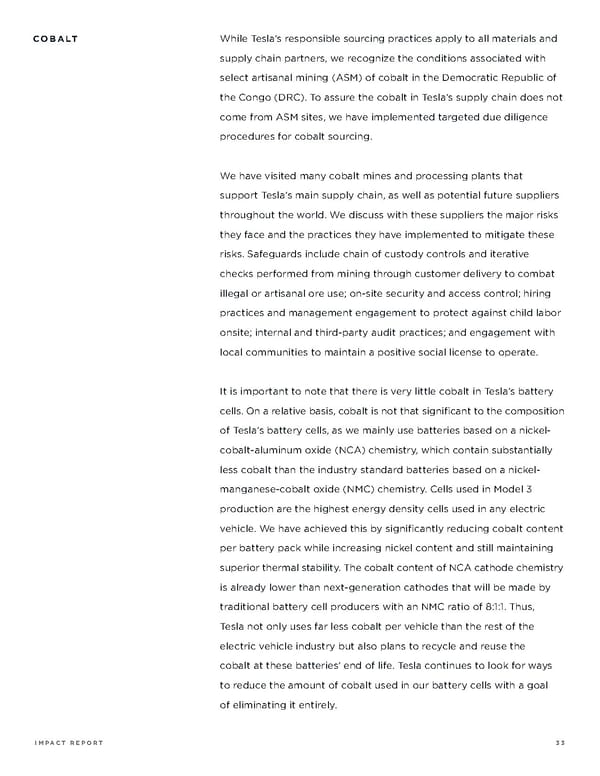COBALT While Tesla’s responsible sourcing practices apply to all materials and supply chain partners, we recognize the conditions associated with select artisanal mining (ASM) of cobalt in the Democratic Republic of the Congo (DRC). To assure the cobalt in Tesla’s supply chain does not come from ASM sites, we have implemented targeted due diligence procedures for cobalt sourcing. We have visited many cobalt mines and processing plants that support Tesla’s main supply chain, as well as potential future suppliers throughout the world. We discuss with these suppliers the major risks they face and the practices they have implemented to mitigate these risks. Safeguards include chain of custody controls and iterative checks performed from mining through customer delivery to combat illegal or artisanal ore use; on-site security and access control; hiring practices and management engagement to protect against child labor onsite; internal and third-party audit practices; and engagement with local communities to maintain a positive social license to operate. It is important to note that there is very little cobalt in Tesla’s battery cells. On a relative basis, cobalt is not that significant to the composition of Tesla’s battery cells, as we mainly use batteries based on a nickel- cobalt-aluminum oxide (NCA) chemistry, which contain substantially less cobalt than the industry standard batteries based on a nickel- manganese-cobalt oxide (NMC) chemistry. Cells used in Model 3 production are the highest energy density cells used in any electric vehicle. We have achieved this by significantly reducing cobalt content per battery pack while increasing nickel content and still maintaining superior thermal stability. The cobalt content of NCA cathode chemistry is already lower than next-generation cathodes that will be made by traditional battery cell producers with an NMC ratio of 8:1:1. Thus, Tesla not only uses far less cobalt per vehicle than the rest of the electric vehicle industry but also plans to recycle and reuse the cobalt at these batteries’ end of life. Tesla continues to look for ways to reduce the amount of cobalt used in our battery cells with a goal of eliminating it entirely. IMPACT REPORT 33
 Tesla Impact Report | 2019 Page 32 Page 34
Tesla Impact Report | 2019 Page 32 Page 34